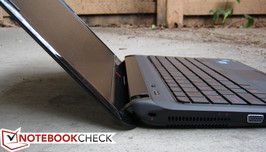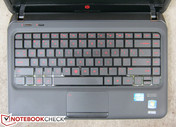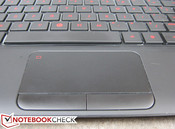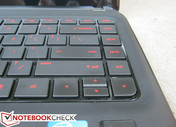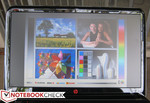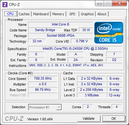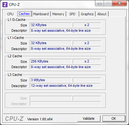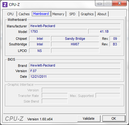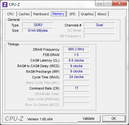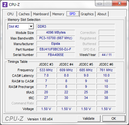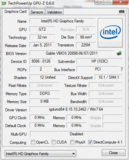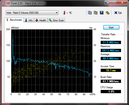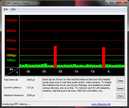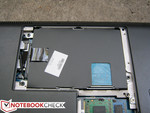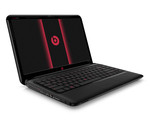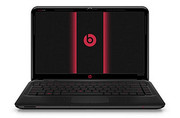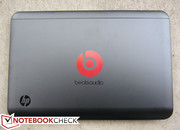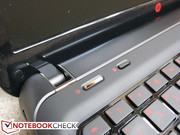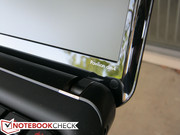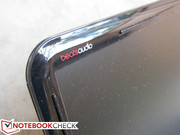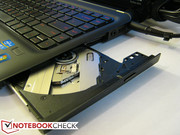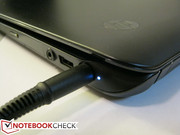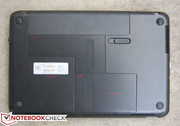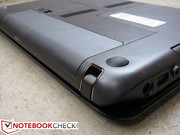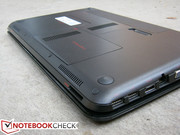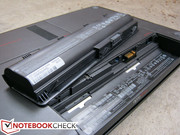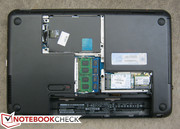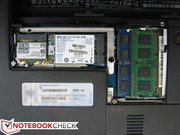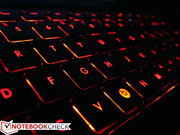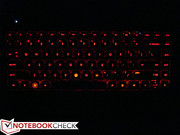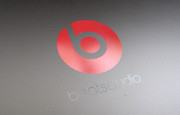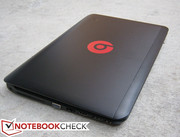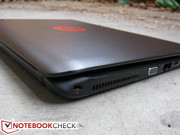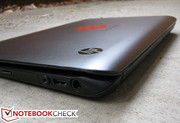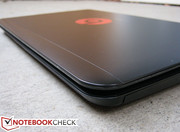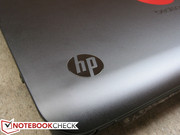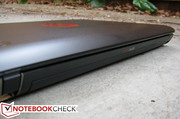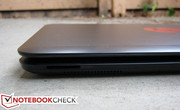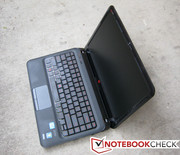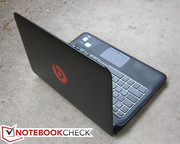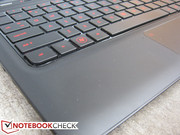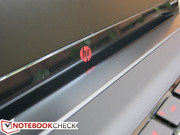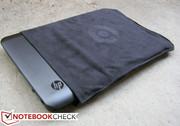HP Pavilion dm4-3090se Laptop Review

Beats Audio, Beats Audio, Beats Audio. If there’s one thing HP wants beaten into your head, it has got to be the Dr. Dre-approved sound company.
While HP isn’t the only proponent of Beats Electronics, they are definitely one of the largest. So large, in fact, that the manufacturer has branded an entire notebook model after the Beats Audio sound system.
Enter the Pavilion dm4-3090se, a multimedia notebook with a special focus on sound quality and with more Beats Audio logos around it than you can count. The slick black and red notebook is part of HP’s dm4tbe series, which so far consists of only 14-inch models but with wide pre-configurable options including specs up to a 2.8GHz Core i7-2640M, discrete Radeon HD 7470M graphics, 16GB RAM and HDD + mSATA hybrid storage.
The unit under review is more middle-of-the-road with a Sandy Bridge Core i5 CPU and integrated Intel graphics, but includes a 20GB mSATA SDD for the above mentioned hybrid storage. Starting at $899 with options reaching north of $1399, the Pavilion dm4 Beats Edition lineup doesn’t come very cheap, although it is still less expensive than the similar Envy 14-2160se Beats Edition. Can a capable, 14-inch non-Ultrabook still wow us at this time of year where ultrathin form factors have taken center stage? We take the dm4-3090se through our usual exhaustive analyses and give our conclusion on what users can expect from the Beats Audio notebook when compared to the current competition.
Case
At first glance, the dm4-3090se is awfully similar to the reviewed Envy 14 Beats Edition. Both products feature smooth, matte black lids with the familiar red Beats Audio logo precisely on the center. But, upon closer inspection, the dm4 sports a plastic case and a brushed aluminum texture with more accentuated curves for an overall unique design both inside and out. We can comfortably say that the chassis here is leagues beyond those of budget notebooks in terms of eye appeal and adequately reflects the $900+ price tag.
For a 14-inch notebook, the dm4 is quite thick from the back at 1.27 inches (32.258mm) but tapers down rather significantly to 0.96 inches (24.384mm) up front. The brushed aluminum lid is slightly angled on the back end as well, which when combined with the rotund design, actually leaves a noticeable and visible gap between the inner lid and the surface directly above the keyboard (see image below). Stability is decent for a lid that is largely plastic, but nothing impressive. For example, applying pressure on any point on the outer lid will unfortunately result in visible depressions even though the lid itself has average resistance to side-to-side twisting.
As with most 14-inchers, opening the lid will require both hands from the user due to the more lightweight base. Once the keyboard and monitor are exposed, the user will quickly notice the rubberized velvety surface, a texture not unlike that found on the Envy 14 Beats Edition. We found the feel to be superior to that of common plastic or aluminum, both of which can experience wider and potentially uncomfortable temperature ranges compared to rubber. It’s worth mentioning, however, that hard-to-clean fingerprints can easily accumulate on the notebook.
We were equally impressed by the stability of the base. Unlike the lid, the surface around the keyboard is solid and firm to both finger depressions and torsional twisting. The chrome-lined hinges work just as well on stiffly holding the lid in place. While we would have preferred an all-aluminum chassis a la the Envy series, the dm4 still surprises with both a tough base and prominent looks; we only wish that the lid could have been more rigid.
Connectivity
Most of the common physical ports associated with multimedia notebooks are included in the Beats Audio Pavilion. Since the back edge is reserved for the battery, almost all ports are found on the left and right edges.
Port placement overtly favors right-handed users because of the close positioning of the USB 3.0 ports and HDMI-out on the left hand side. The lone USB 2.0 port on the right is even more tightly packed; a fat USB drive can easily prevent use of the adjacent AC and 3.5mm audio ports! The compactness can be blamed on the DVD drive tray, but the drawback here may be worth it for those who necessitate physical optical drives in their notebooks. Still, users with larger hands may find it difficult to press open the drive tray. In any case, each port is easy-to-reach and quickly accessible.
Expansion slots like ExpressCard and docking ports don’t exist on the dm4, but such ports are normally aimed at business notebooks. The lack of any eSATA ports can be overseen as well since two USB 3.0 ports are immediately available.
Communication
In terms of wireless connectivity, WLAN is provided by a single-band, dual-stream (1x2) Intel Centrino Wireless-N 1030 with Bluetooth 3.0 and Wireless Display (WiDi) capabilities on top. Outside of these multimedia basics, nothing else is available. Features such as WWAN and GPS are absent, but again, these business-centric options are beyond the scope of this notebook.
Accessories
HP has thrown in a black velvet sleeve with every new Beats Audio Pavilion purchase. The sleeve is the exact same kind as found with the high-end Envy notebooks, save for the Beats Audio logo now replacing the HP logo. The sleeve is especially handy for wiping fingerprints too, but don’t expect it to protect the notebook from major bumps or bruises. Regardless, it is definitely a neat and appreciated extra that we wish other manufacturers could include with their notebooks as well.
As for official optional accessories, HP offers the usual USB devices and port replicators. Specialized accessories catered to the dm4 Beats Edition don’t exist due to the lack of a docking port.
Warranty
The standard HP one-year limited warranty with toll-free phone support applies to each purchase. As usual, warranty can be both upgraded and extended through multiple tiers up to 4 years with optional Accidental Damage Protection and House Call Services. Called the HP Care Pack Service, the warranty ranges from $159 up to $549 for the peak package.
Input Devices
Keyboard
The backlit Chiclet keyboard (30cm by 11cm) is styled with the same black and red colors as the rest of the notebook and contributes rather significantly to its overall sleek design. In particular, the red backlight is a definite standout and an eye-catcher. Not only does the red glow fit in well with the Beats Audio mojo, it is also both a satisfying change to the usual white backlights and, perhaps arguably, more pleasing to the eyes when used in the dark. The crimson lighting even reminds us a bit of Alienware notebooks to a degree. Although the keys themselves are matte, the glossy space between them adds even more to the already attractive design. Fingerprints will also show very easily, so be ready to wipe down the keyboard every now and then.
It’s a certainty that the keyboard looks elegant, but how does it perform? Clatter intensity is typical of average keyboards and tactile feedback is solid without suffering from any spongy impressions. Unfortunately, we found that the shallow key depth took some time to become accustomed to. The longer than usual right Shift key has taken space away from the Up key, resulting in the familiar but unwelcoming tight Directional key formation. The “F” keys (F1, F2, …, F12) are by default associated with the Fn key, but users can easily change this setting in the BIOS if needed.
Touchpad
The smooth touchpad is a bit small at 8.75cm by 4.5cm. Unlike many other notebooks this size, the left- and right-click keys are not integrated underneath the touchpad surface, which takes away from the touchpad in terms of available surface area. Nonetheless, single-touch use and clicking are both responsive and without problems. Multi-touch controls are supported as well, such as pinch-to-zoom, two-finger scrolling and other gestures up to four fingers. Due to the small size of the touchpad, user experience will be mixed as the surface will at times respond incorrectly to multi-touch inputs. This happens increasingly more often for gestures demanding three or even four fingers.
Besides the poor multi-touch responsiveness, the touchpad and quiet click keys work well on a basic level. The depth of the click keys could have been deeper, but that is merely nitpicking at this point. We found that the feature to disable the touchpad by double-tapping the top-left edge to be quite useful, which is a similar function found on HP’s more expensive Envy lineup.
Display
The 14.0-inch antiglare matte display offers an impressive native resolution of 1600x900 pixels. This is higher than many competing notebooks of similar size or even a number of 15.6-inch notebooks where smaller resolutions of 1280x800, 1366x768 or 1440x900 pixels are more common. Even a few Ultrabooks, such as the original Acer Aspire S3 or HP Folio 13, don’t offer as high of a display resolution as the dm4 Beats Edition. This means browsing and word processing should be easier on this notebook because of the larger screen real estate. Granted, for a base price starting at $900, we didn’t expect anything less from the HP notebook. Subjectively, text and images appear crisp and without noticeable issues.
With the Gossen Mavo-Monitor, the HP showed its peak brightness of 212 nits on the center quadrant of the display. The screen itself averages at about 204 nits, which is sufficient for practically all indoor conditions. When the notebook is unplugged, however, brightness drops by a small but noticeable amount, which ultimately limits outdoor use to some extent.
| |||||||||||||||||||||||||
Brightness Distribution: 92 %
Center on Battery: 174.6 cd/m²
Contrast: 163:1 (Black: 1.3 cd/m²)
46.49% AdobeRGB 1998 (Argyll 3D)
65.5% sRGB (Argyll 3D)
44.94% Display P3 (Argyll 3D)
With the XRite i1, we recorded a total gamut volume covering about 68 percent of the sRGB standard. Color reproduction performance is slightly better than most displays on budget notebooks of similar size such as the Dell Inspiron 14r or Sony Vaio VPC-EG27FM. More expensive notebooks, such as mobile workstations, Apple MacBooks or HP’s own Envy series can produce more accurate colors. Still, users who aren’t using the dm4 Beats Edition for professional digital graphics work should find the clean display perfectly suitable for everyday use or video playback.
Outdoor usability is average but usable if under shade. Although brightness could have been higher, the matte display is the dominant attribute that allows the dm4 Beats Edition to be used in some outdoor situations. Glare and displeasing reflections are nonexistent, but we do suggest turning brightness to its maximum and avoiding direct sunlight if possible for the best outdoor viewing experience.
Although the display is good in terms of colors and resolution, viewing angle stability is still typical of mainstream notebooks. That is to say, side-to-side viewing is much more acceptable than viewing from vertical angles. A single user should find no problems with this limitation during everyday use, but the restraining angles can become a problem if multiple users are viewing photos or movies off of the notebook.
Performance
The preconfigured dm4-3090se under review is powered by a dual-core Sandy Bridge Core i5-2450M running at a base 2.5GHz frequency that underclocks to 800MHz when idle. Hyper-Threading and Turbo Boost are supported to roughly emulate quad-core performance and dynamic clock speed boosts up to 3.1GHz, respectively. Similar to other full-voltage mobile Sandy Bridge and Arrandale Core i5 processors, the i5-2450M has a theoretical max TDP of 35 watts including its integrated GPU. More information on this processor and our related benchmarks can be found here on its dedicated page.
The now ubiquitous integrated Intel HD 3000 graphics performs as expected and offers no surprises. The GPU stays at a constant 650MHz with Turbo Boost potential up to 1300MHz. ULV Core ix cpus can sometimes deliver comparatively lower maximum GPU clocks, so at least the integrated Intel GPU in the dm4-3090se can run at full speed. Real-world performance advantages, though, will be barely noticeable to the average user.
For RAM, the dm4 is equipped with dual-channel 6GB DDR3 SDRAM (1x2GB and 1x4GB modules). The two RAM slots are easily accessible by removing one Philips head screw, although users must first remove the battery before gaining access to the screw (not that you should be tinkering with the hardware with the battery attached, anyway). Exposing the RAM will also expose the mSATA drive, UMTS module and HDD immediately adjacent to it.
With the DPC Latency Checker, recurring high peaks were detected even with WLAN inactive. While we weren’t able to identify the source of the high latencies, we suspect that removing most of the background bloatware processes or disabling certain drivers/controllers can address the possible latency concerns.
Processor
In the synthetic CPU-oriented benchmarks, the i5-2450M in the dm4 Beats Edition matches almost perfectly with other notebooks with the same CPU, such as the Sony Vaio VPC-SB4X9EB and Packard Bell EasyNote TS13HR-197GE. This suggests good performance consistency between notebooks with the i5-2450M regardless of manufacturer.
When compared to other CPUs, the i5-2450M in the HP performs slightly better than the i5-2430M on average, but not by any noticeable margins. After all, the i5-2450M is fundamentally an i5-2430M but clocked 100MHz higher. This is a similar case with the i5-2410M – the single-core, multi-core and Cinebench benchmarks compared to the i5-2450M are close enough that the average user may not notice a difference in everyday performance. For example, Super Pi 32M, wPrime 2.0 1024m and Cinebench R11.5 64-bit CPU of the dm4-3090se are 11m36s, 602.36s and 2.75, respectively, compared to the i5-2410M averages of 12m40s, 626.9s and 2.6 in those same benchmarks. For noticeable performance gains, we suggest moving upwards to a Core i7-2640M or even an i5-2520M option, but the standard i5-2450M should be more than enough for everyday tasks.
System Performance
For general system performance, we turn to the synthetic benchmarks PCMark Vantage and PCMark 7. Because of the hybrid HDD + mSATA setup, performance should theoretically increase during constant use as cache is stored and retrieved on the SSD based on what programs the user employs the most. This is exemplified through PCMark Vantage where we ran the benchmark four times consecutively to spot any potential improvements in the final score. While our first run-through returned a score of 8180 points, following runs returned 10545, 10260 and 10258 points, respectively. The latter scores are surprisingly comparable to certain notebooks with dedicated SSDs, such as the Schenker XMG A501 w/ i5-2410M (10786 points) or Toshiba Satellite R850 (10378 points). Subjectively, opening programs such as Microsoft Word or online browsers with multiple tabs appear smooth without any hiccups as well.
| PCMark Vantage Result | 8180 points | |
| PCMark 7 Score | 3687 points | |
Help | ||
Mass storage
Our preconfigured review unit came equipped with a 500GB Seagate 7200RPM ST9500423AS HDD paired with a 20GB Intel 311 Series SSDMAESC020G2 mSATA SDD. Both drives each utilize a 3Gb/s SATA II interface, although the mSATA drive is inaccessible through Windows as it is solely used as system cache and for boosting startup/wakeup times. For example, a cold boot took about 18 seconds from the time user presses the Power button to the instant the Windows 7 desktop appears. This hybrid HDD/SSD setup is a common feature in certain Ultrabooks such as the Acer Aspire S3 where a full-on SSD would have undesirably raised prices beyond the target MSRP. Out of the 500GB HDD, 15.84GB is reserved for system recovery and 445.75GB is immediately available to the user.
According to HD Tune, the HDD averages about 88.9MB/s in transfer rate. The relatively large maximum spike in the beginning of the test was reproducible with subsequent HD Tune runs and may be related to the communication between the HDD and SSD (consequently, HD Tune is notorious for its inaccurate benchmarking of non-mechanical drives). Nonetheless, the 500GB Seagate is one of the faster 2.5-inch 7200RPM drives that are normally found in notebooks. It is quite uncommon to find notebooks with single HDDs reaching north of 90MB/s on HD Tune, with notables being the recently reviewed (and comparatively more expensive) 2012 HP Envy 15 and Envy 17 3D.
For more comprehensive information on various notebook mass storage drives, please refer to our extensive and growing HDD/SSD comparison table.
Gaming Performance
GPU performance is decent for light gaming, but unexceptional. By now, the performance of the integrated Intel HD 3000 graphics has been well-documented in our database, especially now that its Ivy Bridge successor is just around the corner. To put concisely, users can expect the dm4-3090se to play 1080p videos and Flash games flawlessly, but modern 3D games above low-medium settings will be almost assuredly unplayable. We should note that users can customize the notebook with an entry-level Radeon HD 7470M 1GB GDDR5 GPU, but extra-demanding games like Battlefield 3 or Crysis 2 will still be barely playable even on its lowest settings. For an in-depth overview of the gaming capabilities of the integrated Intel HD 3000 graphics, see here. In short, modern gamers should be looking beyond the dm4-3090se for their gaming on-the-go.
| 3DMark 03 Standard | 11401 points | |
| 3DMark 05 Standard | 7416 points | |
| 3DMark 06 Standard Score | 4259 points | |
| 3DMark Vantage P Result | 1921 points | |
Help | ||
Emissions
System Noise
Noise emissions are pleasantly low during normal use and can barely reach 40dB when under maximum load. The fan is always on regardless of workload, but the user will have to listen very closely in order to hear any whirring from the notebook. Noise levels continue to be barely audible when browsing or word processing as well.
DVD access and playback noise are equally impressive as the system fan. Hovering around 35dB, we found no ambient noise problems when playing DVD movies directly from the disc. When taking into account the full-voltage dual-core CPU, the dm4 Beats Edition has certainly surprised us with its overall quietness.
Noise level
| Idle |
| 31.3 / 31.5 / 31.7 dB(A) |
| DVD |
| 35.5 / 36.1 dB(A) |
| Load |
| 38.8 / 39 dB(A) |
 | ||
30 dB silent 40 dB(A) audible 50 dB(A) loud |
||
min: | ||
Temperature
With fan noise relatively low, we would have expected overall temperature to be at least somewhat inversely proportional. The dm4-3090se surprises us yet again with reasonably low surface temperatures, even when under load.
Idle temperatures averaged about 27 and 29 degrees C on the base and underside surfaces, respectively. Although minor in extent, the gradient expectedly moves from high to low starting on the quadrant closest to the vent. As a result, the user’s left palm may feel a bit warmer than the right when typing; a sensation that will only become more obvious as the system becomes more stressed.
When under maximum CPU and GPU load, average temperatures only rose about 4 degrees C on both sides. The hottest spot of 38.6 degrees C was predictably on the underside quadrant closest to the vent, which was a whole 13 degrees warmer than the coolest quadrant on the notebook. Surface temperatures overall remained within comfortable zones and we expect users to be able to use the notebook on one’s lap for browsing, video playback and word processing without any heat issues.
(+) The maximum temperature on the upper side is 36 °C / 97 F, compared to the average of 34.3 °C / 94 F, ranging from 21.2 to 62.5 °C for the class Office.
(+) The bottom heats up to a maximum of 38.6 °C / 101 F, compared to the average of 36.8 °C / 98 F
(+) In idle usage, the average temperature for the upper side is 27.3 °C / 81 F, compared to the device average of 29.5 °C / 85 F.
(+) The palmrests and touchpad are reaching skin temperature as a maximum (32 °C / 89.6 F) and are therefore not hot.
(-) The average temperature of the palmrest area of similar devices was 27.6 °C / 81.7 F (-4.4 °C / -7.9 F).
For our throttling test, we utilized both Prime95 and FurMark in order to fully stress the CPU and GPU, respectively, and used HWiNFO to monitor the hardware. The CPU was fully stressed first to observe its untethered maximum dual-core Turbo Boost potential. Here, Turbo Boost worked as advertised and safely hovered between 2800MHz and 2900MHz on both cores. Similarly, the Intel integrated 3000 GPU was able to maintain its 1300MHz Turbo Boost clock speed with only FurMark active.
As per usual with Sandy Bridge notebooks, the maximum potential of both processing units noticeably decreases when the entire system is under full stress. To simulate the condition, we ran both Prime95 and FurMark simultaneously for over two hours uninterrupted. The CPU was able to run at a constant 2500MHz while the GPU leveled off at 650MHz with the occasional and short-lived jumps up to 900MHz. The CPU/GPU cores weren’t able to reach 90 degrees C even by the end of the testing, suggesting that the TDP may be the limiting factor preventing these cores from running at higher clocks during our stress test.
The take home message is that both the CPU and GPU never dropped below their base speeds of 2500MHz and 650MHz, respectively, during the test above. To confirm no throttling issues, we immediately ran 3DMark 06 following the stress test and returned with virtually the same end scores.
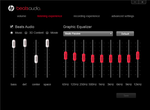
Speakers
If the notebook is named after an audio company, it better produce some excellent sounds. Fortunately for the dm4 Beats Edition, the dual speakers and single subwoofer do their jobs very well for a 14-inch notebook, but are nothing to write home about.
The speakers are located on the front edge and angled towards the desk instead of the user, a common setup that can also be found on other notebooks like the Lenovo X121e. Bass in music is much improved over budget notebooks and volume can be enough to fill a whole conference room if needed. Perhaps surprisingly, sound distortion is very minimal if on louder volume settings. While overall quality is better than average, we still feel that external speaker solutions should be used for better music and movie experiences in the long run.
On the software side, the sound system here runs on the same Beats Audio software as found on the recently reviewed 2012 Envy 15. This means that users can easily manipulate sound output with a graphic equalizer and other specialized volume options.
For a notebook advertised around its audio features, we were disappointed to find only one 3.5mm combo audio jack for headphones and mics. The fantastic analog volume control knob as seen on the 2012 Envy 15 is also nowhere to be seen, which would have been a great feature for a Beats Audio notebook such as this.
Battery Life
Power consumption
The dm4-3090se comes standard with a 6-cell 55WHr battery module, although users can opt for a physically larger 9-cell battery for a theoretical 50 percent longer battery life.
Our review unit came equipped with the standard 6-cell which offers respectable runtimes for the notebook. To test maximum battery life, we disabled Sleep, CoolSense, keyboard backlight and WiFi and ran the BatterEater Reader’s Test at minimum brightness under the Power Saver profile until the notebook shut itself off. Under these conditions, the system lasted for 8 hours and 5 minutes.
Minimum battery life was tested with the Battery Eater Classic Test setting at maximum brightness, connected WiFi and disabled keyboard backlight under the Performance profile setting. The notebook drained itself out in merely 64 minutes.
For a more reality-based test, we set the notebook in the Balanced profile at 150 cd/cm2 brightness with connected WiFi and ran our standard looping script to simulate online browsing with the occasional videos. The system ran for 6 hours before shutting down.
This is our first review of the Core i5-2450M in a 14-inch notebook, so we unfortunately do not have another similarly-sized model to directly compare the HP notebook to as of this writing (our recently reviewed 15.6-inch Acer TravelMate 5760G and Packard Bell EasyNote LS11HR both ran on i5-2450M CPUs). But, when compared to other 14-inch notebooks with full voltage Core i5 Sandy Bridge CPUs, the dm4 Beats Edition is pretty much on par with many models. For example, the HP notebook clocks in an hour or two longer than the sleek Lenovo IdeaPad U400, but lasts a bit shorter than the Sony Vaio VPC-EG27FM and is only a bit longer-lasting than the Samsung Series 7 700Z3A.
In other words, battery life off of the standard battery is good but not remarkable. Users may be able to squeeze in a whole 8-hour day of light use, but having an AC adapter nearby is the safer bet for anything more.
Verdict
Drawing a final impression on the HP dm4-3090se is difficult. On the positive side, the notebook reflects its price reasonably well in key areas including the sleek designs, rubber padding, red backlit keys, high resolution display, respectable sound output, low fan noise and temperatures and great general performance with its hybrid HDD/SSD setup. When standing alone, the HP notebook can easily be seen as above average across most 14-inch categories.
Unfortunately, the dm4-3090se is anything but alone in the notebook world. The asking price of $899 is a bit steep for a non-ultrathin notebook without a dedicated GPU or full aluminum alloy body, especially at this time in the mobile market. 2012 is the year that Ultrabooks are expected to bloom in full force, many of which are already selling for $899 with dedicated SSD storage, thinner and lighter builds, higher quality aluminum frames and promise of longer battery lives. The dm4 Beats notebook is by no means bad, but it doesn’t have the oomph or aggressiveness needed to standout in the 14-inch notebook market that is progressively shifting towards less expensive Ultrabooks. Unless HP can offer the dm4-3090se starting for a couple hundred less, the ultrathin category could have a very good chance of overshadowing this speedy-but-quiet 14-incher in a heartbeat.
Accordingly, for users who intend to use the dm4-3090se mainly as a travel companion, we suggest taking a good look at the HP Folio 13 Ultrabook that also starts at $899 and includes options for an ULV Core i5 CPU with a 128GB SSD, backlit keyboard and 9+ hours of battery life. The stiffer rigidity of the Folio 13 makes the Ultrabook more suitable for constant traveling as well.
Otherwise, those looking for a more indoor multimedia-centric notebook may want to invest $150 to $200 more for a vastly superior HP Envy 15 notebook, which has an aluminum alloy chassis and undeniably stronger qualities than the dm4 Beats notebook.
In short, the dm4-3090se is a wonderful looker and performer. But, for a $900 starting MSRP, one doesn’t have to look too far for better deals as even HP’s own alternative lineups offer better bang for the buck at this price range.




